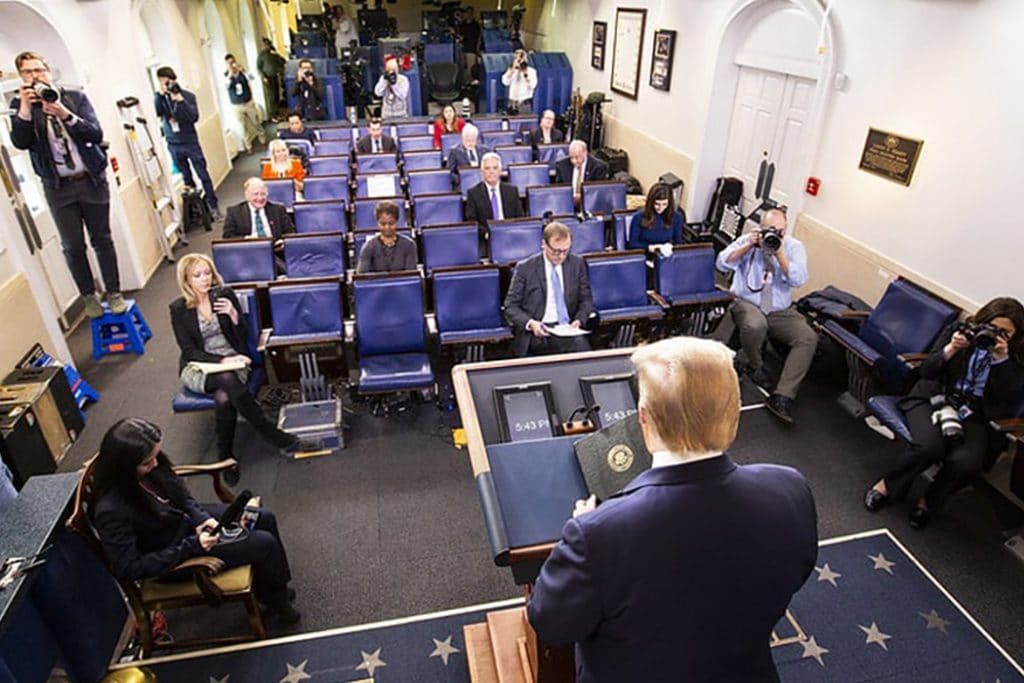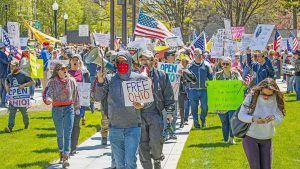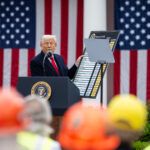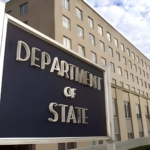Reporting on science in today’s hyperpolitical environment
By Herbert Lin | August 18, 2021
 President Trump takes the podium at a press briefing on the coronavirus pandemic. Credit: White House
President Trump takes the podium at a press briefing on the coronavirus pandemic. Credit: White House
Editor’s note: Herbert Lin is a member of the Bulletin’s Science and Security Board (SASB), and the following members of the SASB have expressed concurrence with this paper: Steven Fetter, Asha George, Rod Ewing, Suzet McKinney, Rob Socolow, Daniel Holz, Robert Latiff, Sharon Squassoni, Scott Sagan, and Robert Rosner.
Since early 2020, huge efforts have been expended on combatting the COVID-19 pandemic. Understanding how the SARS-CoV-2 virus sickens and kills humans, how it spreads and mutates, and how to vaccinate against and treat the virus has been the top global priority—from a scientific, medical, and humanitarian standpoint, uncovering the origin of the virus has been a secondary goal, though necessary to help the world organize itself to mitigate future pandemics. Unfortunately, a number of political leaders have turned various aspects of the pandemic into potent political symbols with the apparent intention of scoring political points both domestically and internationally rather than taking actual steps to address real problems.
In such an environment, those who seek to provide an honest and accurate account of the state of the science and public health issues underlying the pandemic must also be cognizant of how such accounts are received. The Bulletin of the Atomic Scientists is in just such a position—in reporting on issues at the nexus of science and public policy, its mission is to present a variety of responsible views where no scientific consensus yet exists. And yet it must do so understanding that various political actors are all too prone to exaggerate viewpoints that appear to support their positions and to denigrate those that oppose their positions, with little regard for the actual facts on which the viewpoints are based.
The ongoing debate over the origin of the SARS-CoV-2 virus offers a perfect illustration of this dynamic at work. Two competing hypotheses have been advanced about the origin of the SARS-CoV-2 virus that causes the disease. One hypothesis involves natural emergence—perhaps SARS-CoV-2 evolved naturally in bats somewhere in China and eventually found its way to human beings. A second hypothesis suggests that the SARS-CoV-2 virus had been contained within a Chinese lab and managed to escape the lab confines, the so-called “lab leak” theory.
Early in the pandemic (around the second quarter of 2020), the majority of the scientific community in both the United States and in other nations seemed to coalesce around natural emergence. Notably, high-level political officials in the Trump Administration favored a version of natural emergence, asserting that a naturally occurring zoonotic disease passed from animals to humans in an unsafe manmade environment (the “wet” market). Later, they settled on the lab leak theory, noting that the lack of proof that the wet markets were to blame. Most curiously, they rarely if ever provided evidence or argument for any of these views that they were willing to make public.
On May 5, 2021, the Bulletin published a story by Nicholas Wade entitled “The origin of COVID: Did people or nature open Pandora’s box at Wuhan?”[1] Wade sought to compare and contrast the natural emergence theory to the lab escape theory, looking at the available information. Although he was careful to say that neither theory can be ruled out by direct evidence, he concluded that in his judgment, the lab escape theory is more consistent with the origin of the pandemic than the natural emergence theory.
The Washington Post suggested that the story by Wade was a major factor in shifting the debate over the virus’s origins.[2] It did shift the debate as reported in major media outlets, but vigorous discussion about the origin of COVID-19 had been taking place in scientific circles over the preceding year. Over that year, many prominent scientists vigorously supported a theory of natural emergence (see https://www.nature.com/articles/s41591-020-0820-9, for example). Other prominent scientists argued just as vigorously that the possibility of a lab leak needed to be seriously investigated (see https://www.pnas.org/content/117/47/29246, for example).
Months before the Wade story was published, in fact, more than 20 prominent experts signed an open letter calling for a “Full and Unrestricted International Forensic Investigation into the Origins of COVID-19,” that would include both natural emergence and a lab accident as possibilities (see https://s.wsj.net/public/resources/documents/COVID%20OPEN%20LETTER%20FINAL%20030421%20(1).pdf).
Less than two weeks after publication of the Wade story, a number of prominent scientists published a letter in Science on May 14, 2021[3] stating that “[t]heories of accidental release from a lab and zoonotic spillover both remain viable,” and that “we must take hypotheses about both natural and laboratory spillovers seriously until we have sufficient data.” Such writings have led a number of scientists and policy makers to take more seriously the possibility of a laboratory leak along with the possibility of natural emergence.
The publication of the Wade article, along with four others with a similar theme,[4] were consistent with the Bulletin’s philosophy of speaking truth to power, explaining scientific disputes, and keeping the pressure on leaders to get to the bottom of science-based questions and man-made threats. But, of course, such a comment does not mean that such articles are released into a political vacuum. Understanding their political impact requires a brief recounting of the turmoil of 2020, shaped by two powerful and influential forces.
A first force was a lack of knowledge about the true nature of COVID-19. In early 2020, many scientists and medical professionals believed—incorrectly—that it was very similar to other respiratory illnesses they had known and treated it as such. But it was not, and the virus spread rapidly, laying bare the inadequacy of US preparations to handle such a massive surge. The second force was the looming presidential election in November, which in the wake of President Trump’s controversial first term magnified criticism of how the administration was managing the emerging crisis. Thus, the US response to COVID-19 immediately took on strong political overtones and transformed the best available public health advice (such as wearing masks) into partisan loyalty tests. Overtly racist rhetoric, bipartisan perceptions of China as the new peer adversary, and a president prone to misstatements and outright lying exacerbated the consequences of this transformation.
The context of the current debate on the pandemic’s origin. Early in the pandemic, public health authorities were emphasizing droplet transmission as a primary mode for spread of the virus. Personal protective equipment, such as masks and hand sanitizer, was scarce even for front-line medical workers. Ventilators were (and remain) in short supply. Diagnostic tests for the virus were initially unavailable, and when they were developed, the demand for testing far outstripped supply—and test results were initially questionable and took too many days to be useful. The finest hospital systems in the world were overwhelmed with acute cases, with refrigeration trucks holding dead bodies parked outside. Perhaps most significant, the World Health Organization noted in the first few months that the pandemic and response had been accompanied by a massive “infodemic”—an over-abundance of information, some accurate and some not—that made it hard for people to find trustworthy sources and reliable guidance when they needed it.[5]
Even as this chaotic tragedy unfolded, political leaders downplayed the severity of the outbreak. In the United States especially, with the November 2020 election fast approaching, the response to the pandemic rapidly became politicized. Sensible public health measures—such as social distancing and non-medical-grade masking—became political statements. Unproven treatments were touted at the highest levels of government. A cruise ship with infected Americans was initially prevented from docking stateside, even as President Trump complained that its arrival at a US port would increase the official count of US victims,[6] although that decision was eventually reversed.[7] President Trump complained that testing for COVID-19 “makes us look bad.”[8] A few days later, he said he had asked to “slow the testing down.”[9] And at a White House press conference, he asserted that “[w]hen you test, you create cases.” To treat COVID-19, he endorsed a variety of unproven therapies, such as hydroxychloroquine, and suggested that ingesting bleach would help kill the virus. Senior administration officials and their political surrogates systematically undermined and attacked the scientists at the National Institutes of Health, the Centers for Disease Control and Prevention, and the Food and Drug Administration who were responsible for developing and implementing a science-based response, thus undercutting the credibility of all figures with scientific expertise or authority.

Ineptitude at the highest levels of the US government was compounded by three other problems: Trump’s overt racism, the administration’s perception of China as a hostile adversary (shared to some degree by Democrats), and a variety of unsubstantiated claims on all manner of topics. Long before the COVID-19 pandemic, Trump’s rhetoric had racist overtones and sometimes was overtly racist. In the 2016 campaign, he said of Mexican immigrants: “They’re bringing drugs. They’re bringing crime. They’re rapists. And some, I assume, are good people.” He claimed that Black Americans were responsible for the majority of murders of white Americans and repeatedly tied African Americans and Hispanics to violent crime.[10] After he was inaugurated, he drew an equivalence between white supremacists and those who protested against them, saying there were “very fine people” on both sides. He referred to El Salvador, Haiti, and African nations as “shithole countries.” And of particular significance, referred to SARS-CoV-2 as the Kung Flu, a phrase that White House Counselor Kellyanne Conway had previously described as “wrong” and “highly offensive.”[11]
In addition, the Trump administration’s National Security Strategy of 2017 had declared that “China and Russia … are determined to make economies less free and less fair, to grow their militaries, and to control information and data to repress their societies and expand their influence.”[12] In particular, China was “seeking to shape a world antithetical to U.S. values and interests … [and] seek[ing] to displace the United States in the Indo-Pacific region, expand[ing] the reaches of its state-driven economic model, and reorder[ing] the region in its favor.” It has “expanded its power at the expense of the sovereignty of others … [and] gathers and exploits data on an unrivaled scale and spreads features of its authoritarian system, including corruption and the use of surveillance.”[13] Issues related Chinese cyber-enabled theft of intellectual property and its apparent vacuum-cleaner approach to gathering scientifically and technologically useful information produced in the United States, US trade deficits with China, Chinese activities in the South China Sea that challenge the United Nations Convention on the Law of the Sea and other international law, and other economic and financial matters further exacerbated tensions between the two nations.
Finally, the Trump administration severely challenged the historical reputation of the executive office of president of the United States for transparency and honesty. According to the Washington Post, in the first three years of his presidency, Trump himself averaged about six false or misleading claims per day in his first year as president, 16 per day in his second year, and 22 per day in his third year.[14] By March 1, 2020, he had accumulated nearly 17,500 such claims.[15]
With this backdrop, it is easy to see how the simplicity of a lab leak for which China is blamed can be used to arouse animus against China among people who don’t know or care much about the details of Sino-American relations.
The difference between politics and scientific inquiry. Given an administration prone to misleading statements and determined to see China as a mortal geopolitical enemy, a certain degree of skepticism when the administration proffered a Chinese lab leak in early 2020 without evidence was both unsurprising and reasonable. A lunatic can be right every now and then; still, the smart bet in general is against the lunatic. Moreover, the administration asserted certainty when there was none, as if its own intuitions (some might call them prejudices) were an adequate substitute for scientific analysis—especially when evidence and historical precedent also supported (and continue to support) the viability of a theory of natural emergence. Theories advanced without evidence by politicians or journalists, backed only by speculation masquerading as certainty and with a vested interest in advancing them are often treated as conspiracy theories—even if there is a chance of their being right.
If science has any epistemological authority, it rests on a process that is supposed to filter out the effects of individual perceptions and intuitions and instead relies on logic, observation, and empirical evidence. From time to time, at least in the short term, the scientific process does not work perfectly—a second article by Wade published August 17 suggests, though mostly through insinuation, that political considerations were prominent in changing the views of certain experts regarding the virus’s origins.[16] But occasional real-world failures in the scientific process do not mean that the perceptions and intuitions of any one person are superior, even if that person is the president of the United States. Many policy makers who crave the legitimacy that science may confer on various policy positions (such as China’s alleged responsibility for a laboratory leak) have no use for the rigor or methods of scientific inquiry (e.g., the use of logic, the search for contradictions, the reliance on data, the use of peer review), and thus have no qualms about attacking the scientific enterprise as a whole when the scientific consensus goes against them.
In early 2020, natural emergence was the dominant, though not the only, theory for the virus’s origins based on the evidence available at the time. Since then, more evidence has been accumulated and more analysis done. And, most important, a new administration—one with a greater understanding of the proper value and use of science in public policy—has taken office. With these changes, the lab leak theory has gained some measure of additional credibility—and some scientists who had been fearful of their work being weaponized in service of Trump’s anti-China agenda felt freer to express their belief that a lab leak was one of a number of hypotheses regarding the virus’s origins that should be investigated. From a scientific point of view, the increased credibility of the lab leak theory is not a bad outcome. To a degree that does not characterize hyper-partisan political leaders, scientists learn, and with more analysis and evidence, often change their minds.
The history of science clearly demonstrates that some theories—thought absurd when first proposed—have eventually gained some respectability after further vetting by the scientific community. To the extent that the Bulletin’s publication of the Wade article in May, and that of the Field and Leitenberg articles a year earlier, have contributed to the evolving scientific understanding of COVID-19’s origins, the Bulletin has done its job. Nevertheless, it must be made clear that many theories are initially thought to be absurd never gain respectability, and the number of such theories is vastly greater than those that do. And the fact that a given theory is initially thought to be absurd is not evidence that it will eventually be vindicated.
Mitigating the second-order consequences of reporting on scientific debate. Because reporting on controversial science in a hyperpolitical environment inevitably has consequences, it is important to emphasize the following points:
- The increased scientific attention to the lab leak theory does not prove that the SARS-CoV-2 did indeed leak from a Wuhan laboratory. Natural emergence continues to be a strong possibility. At this stage, the evidence supporting one theory or opposing the other is circumstantial. It is for this reason that more research—including on-the-ground data collection and examination of Wuhan laboratory records—is necessary, and China does itself no favors by preventing access to these data and records.
- Even if the lab leak theory is true, it does not mean that the virus was deliberately engineered to be particularly infectious to humans, as some have implied. So-called gain-of-function research on coronaviruses could have produced SARS-CoV-2, but it is also possible that a sample of naturally occurring SARS-CoV-2 escaped the laboratory because the sample infected a less-than-entirely-careful, probably asymptomatic laboratory worker, and that worker carried the virus out of the laboratory without any knowledge of having done so.
- Even if SARS-CoV-2 was deliberately engineered as an aspect of gain-of-function research, it does not mean that such engineering was part of an effort to develop it into a biological weapon. Such a weapon has strategic or military utility only if an effective vaccine or an antidote is developed concurrently and is used before or is made available immediately upon release, and it appears that no such measure was available in China for many months afterwards. Gain-of-function research, moreover, while controversial and risky, is not necessarily objectionable in intent, as it can also be used to identify and prepare for potential future outbreaks by helping scientists to understand which mutations most increase the danger of naturally evolving viruses.
The conclusion offered in Wade’s May article that the lab leak theory is more likely to be true than the natural emergence theory will tend to inflame anti-China sentiment around the world, even if the scientific evidence is ambiguous. Such sentiment will make it more difficult for the world to acknowledge China’s contributions to fighting the virus (such as its prompt publication of the virus’s DNA sequence in January 2020) and to enlist China’s cooperation in providing access to primary data from the Wuhan Institute of Virology that would help to decide more definitively among competing theories. It is possible, and important, to be able both to critique China’s failures and recognize its achievements, just as the United States may be considered to have both failed miserably in confronting the pandemic as it unfolded and to have triumphed in vaccine development later. Here, the bottom line is that science is fundamentally international in character today, with the United States and China being the two most scientifically productive nations in the world for the foreseeable future. Building more walls to scientific cooperation and collaboration—especially between those two nations—is worse than cutting off a nose to spite a face. It’s cutting off an entire head to spite its face.
Instead of focusing energy and attention on the Chinese aspects of a lab leak theory, it would be more productive to focus on the safety aspects of the lab leak theory. Indeed, Stanford University microbiologist David Relman has pointed out that lab leaks happen all over the world, and not just in China, though China too has had its share of leaks in the past.[17] It is far more important to improve biosafety around the world and to consider the risks and benefits of various kinds of gain-of-function research, so as to develop guidelines for deciding when such research is too potentially dangerous to be performed.
Moreover, as the Bulletin noted in its 2021 clock statement, “national leaders and international organizations can prepare for biological events before they occur by more carefully monitoring animal-human interactions and improving international disease surveillance and reporting efforts; increasing world capacity to produce and quickly distribute medical supplies; and expanding hospital capacity. National leaders and international organizations can create more effective regimes for monitoring biological research and development efforts, so potential benefits can be maximized, and possible negative consequences minimized or eliminated.” World leaders can also support “an improved global public health effort to prevent, detect, respond to, and recover from natural pandemics [that] would better prepare the world to respond to biological accidents and attacks.”
Of equal concern are the domestic implications of trying to discuss the lab leak theory in a rational manner. We have already seen increased anti-Asian sentiment among the citizenry at large, increased levels of physical violence against Asians, and boycotts of Asian-owned businesses.[18] Suspicions about the loyalties of Chinese-Americans, already on display in a 2019 Bloomberg news study about a higher rate of security clearance denials for Chinese-Americans than for other groups,[19] are likely to grow even further.
Mitigating such outcomes will require a full court press to avoid guilt by association. A study reported in the American Journal of Public Health examined the influence of a Trump tweet including the phrase “Chinese Virus” on other tweets including references to #covid19 and #chinesevirus, finding that tweets with anti-Asian sentiment significantly increased after the Trump tweet.[20] As the Washington Post noted,[21] “words matter, and politicians and members of the news media need to be more careful with theirs. If they are opining about negative actions of the Chinese government or individual scientists, they should say that rather than use blanket terminology to criticize ‘China’ or ‘the Chinese.’ They should also remind the public that questioning the actions of government authorities should not be equated with distrust or hatred of the Chinese people—or of Chinese Americans or others of Asian heritage.” Law enforcement efforts to protect the Asian-American community and to prosecute hate crimes against Asian-Americans must also be stepped up.
Looking to the future, it is important for policy makers around the world to learn and know as much as possible about the origins of SARS-CoV-2. One effort by the World Health Organization with this focus has come and gone, stymied in part by the refusal of the Chinese government to allow access to sources of primary data. Other efforts will be needed in the future to learn the full story of the virus’s emergence.
A topic does not become important merely because it is controversial, but it is nevertheless critical to explore a variety of responsible viewpoints on important topics, even when they are controversial. The Field and Leitenberg articles and the first Wade article raise the profile of the lab leak theory. A news article in Nature considered both theories much as the first Wade article did, also concluding that there was no direct evidence conclusively pointing to one or the other, but came down in another and different “on-balance” judgment that the available evidence indicated that natural emergence was a more likely possibility than lab leak.[22] The argument in the scientific community over origins is essentially an argument about the weight that a given item of indirect or circumstantial evidence should be given. Those that judge a given theory as more likely assign a greater significance or probability of relevance to evidentiary items pointing in that direction and a lower significance or probability to items pointing in the other direction. As Ali Nouri pointed out in his Bulletin article of May 15, 2020, this fundamental truth was ignored when President Trump and Secretary of State Pompeo said the evidence suggested with a high degree of confidence that the Wuhan Institute of Virology was the source of the SARS-CoV-2 pandemic, even as the Office of the Director of National Intelligence stated that it was still studying “whether the outbreak began through contact with infected animals or if it was the result of an accident at a laboratory in Wuhan.”
What is most needed today moving forward is to focus attention on actions that are required regardless of which theory is true. Even if definitive, direct evidence of the theory of natural emergence is found, the world still needs to focus substantial attention and resources on questions of lab safety, regulation, and governance. Even if definitive, direct evidence for the lab leak theory is found, the world still needs to focus substantial attention and resources on disease surveillance. In either case, the world needs to build international institutions that can mount a rapid scientific and logistical response to the emergence of a pandemic. Politicians should refrain from claiming certainty when no such certainty exists. And everyone should recommit themselves to following evidence and exploring careful analysis in an open manner, while calling out the misuse of information to promote prejudice or exploit fear.
Notes
[1] https://thebulletin.org/2021/05/the-origin-of-covid-did-people-or-nature-open-pandoras-box-at-wuhan/
[2] https://www-washingtonpost-com.stanford.idm.oclc.org/opinions/2021/06/03/case-that-virus-emerged-nature-not-lab-is-falling-apart/
[3] Jesse D. Bloom et al., “Investigate the Origins of COVID-19,” Science 372, no. 6543 (May 14, 2021): 694–694, https://doi.org/10.1126/science.abj0016.
[4] Matt Field’s article of March 30, 2020 (https://thebulletin.org/2020/03/experts-know-the-new-coronavirus-is-not-a-bioweapon-they-disagree-on-whether-it-could-have-leaked-from-a-research-lab/) reported on among the first murmurings within the scientific community that the virus may have escaped from a laboratory. He also suggested lab safety posed problems in China as well in the United States. Milton Leitenberg’s article of June 4, 2020 (https://thebulletin.org/2020/06/did-the-sars-cov-2-virus-arise-from-a-bat-coronavirus-research-program-in-a-chinese-laboratory-very-possibly/) presented substantial circumstantial evidence for a laboratory escape of the virus, noting that such a possibility is “most definitely not a conspiracy theory” and that researchers understood that the possibility of laboratory escape of the pathogen was “a plausible, if unproven, possibility.” Filippa Lentzos’ Bulletin article of May 18, 2020 (https://thebulletin.org/2020/05/will-the-who-call-for-an-international-investigation-into-the-coronaviruss-origins/) called for a World Health Organization effort dedicated to a forensic investigation regarding the origin of SARS-CoV-2 was one part of the call for developing such knowledge. A Bulletin article by Nicholas Evans and Anna Muldoon published on August 9, 2021(https://thebulletin.org/2021/08/covid-19-lab-leak-theory-gain-of-function-is-a-hot-topic-but-a-bad-explanation/)
[5] https://www.who.int/docs/default-source/coronaviruse/situation-reports/20200202-sitrep-13-ncov-v3.pdf
[6] https://youtu.be/ExWLn86Mu_g
[7] https://www.nytimes.com/2020/03/09/us/coronavirus-cruise-ship-oakland-grand-princess.html.
[8] https://www.voanews.com/covid-19-pandemic/trump-if-we-stop-testing-wed-have-fewer-cases.
[9] https://apnews.com/article/virus-outbreak-donald-trump-ap-top-news-joe-biden-tulsa-476068bd60e9048303b736e9d7fc6572.
[10] Philip Bump, “Perspective | Trump’s Candidacy and Presidency Have Been Laced with Racist Rhetoric.” Washington Post, January 12, 2018, http://www.washingtonpost.com/news/politics/wp/2018/01/11/trumps-candidacy-and-presidency-have-been-laced-with-racist-rhetoric/.
[11] https://globalnews.ca/news/6698597/donald-trump-coronavirus-racism/
[12] https://trumpwhitehouse.archives.gov/wp-content/uploads/2017/12/NSS-Final-12-18-2017-0905.pdf, page 2.
[13] https://trumpwhitehouse.archives.gov/wp-content/uploads/2017/12/NSS-Final-12-18-2017-0905.pdf, page 25.
[14] https://www.washingtonpost.com/politics/2021/01/24/trumps-false-or-misleading-claims-total-30573-over-four-years/ics/2021/01/24/trumps-false-or-misleading-claims-total-30573-over-four-years/
[15] https://www.washingtonpost.com/graphics/politics/trump-claims-database/
[16] https://thebulletin.org/2021/08/how-covid-19s-origins-were-obscured-by-the-east-and-the-west/
[17] David Relman, “Perspective | Lab Leaks Happen, and Not Just in China. We Need to Take Them Seriously.” Washington Post. June 2, 2021. http://www.washingtonpost.com/outlook/2021/06/02/lab-leak-investigate-risky-research/.
[18] According to the Washington Post, “Since the beginning of the pandemic, people of Asian descent have been blamed for coronavirus, and harassed and assaulted as a result. In Texas, a man allegedly stabbed three members of an Asian American family, including children ages 2 and 6, because they were ‘Chinese and infecting people with the coronavirus.’ A medical student was assaulted near her hospital in New York City, with the perpetrator shouting ‘Chinese virus.’ In Boston, a doctor taking care of covid-19 patients was followed as she left the hospital by someone who shouted profanities and asked her why the Chinese were killing people. According to the nonprofit Stop AAPI Hate, more than 6,600 anti-Asian American and Pacific Islander incidents have been reported between March 2020 and March 2021.” https://www.washingtonpost.com/opinions/2021/06/01/we-need-investigate-lab-leak-theory-without-inflaming-anti-asian-hate.
[19] A Bloomberg News analysis of more than 26,000 security clearance decisions for federal contractors since 1996 showed that from 2000 through 2009, clearance applicants with connections to China—such as family or financial relationships—were denied Pentagon clearances at the same rate as applicants with links to all other countries. But from 2010 through Oct. 31 2019, the China-related denial rate jumped from 44% to 61%, and the rate for all other countries fell from 44% to 34%. That is, more than three-fifths of applicants who have family or other ties to China are rejected for security clearances to work for government contractors, while two-thirds of applicants with ties to other countries are approved. See https://www.bloomberg.com/news/features/2019-12-10/the-u-s-government-s-mistrust-of-chinese-americans. See also https://www.technologyreview.com/2021/06/27/1027350/anming-hu-china-initiative-research-espionage-spying/.
[20] https://ajph.aphapublications.org/doi/10.2105/AJPH.2021.306154
[21] https://www.washingtonpost.com/opinions/2021/06/01/we-need-investigate-lab-leak-theory-without-inflaming-anti-asian-hate/
[22] https://www-nature-com.stanford.idm.oclc.org/articles/d41586-021-01529-3
Together, we make the world safer.
The Bulletin elevates expert voices above the noise. But as an independent nonprofit organization, our operations depend on the support of readers like you. Help us continue to deliver quality journalism that holds leaders accountable. Your support of our work at any level is important. In return, we promise our coverage will be understandable, influential, vigilant, solution-oriented, and fair-minded. Together we can make a difference.
















This lawsuit seems to me to be a more sensible approach than trusting to improved safety procedures. There have been a number of harmful lab leaks that never made the front pages. The nature and funding of research should be open to public scrutiny. CFS is the Center for Food Safety. “Since its inception in 1997, CFS has closely monitored the federal government’s decision-making process in regards to federal agencies’ regulatory authority over genetically engineered (GE) organisms that could adversely affect human health, animal welfare, and the environment, including laboratory-generated potential pandemic pathogens. As part of this oversight and advocacy… Read more »